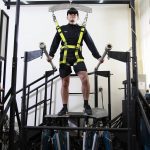

Alcance del Servicio: Analizar el cuerpo humano en la marcha, en puestos de trabajo, en deporte y en danza...

Alcance del Servicio: Evaluación de herramientas de diagnóstico y de dispositivos para procesos de rehabilitación y uso de prótesis u ortesis...

Alcance del servicio: Desarrollo de productos especializados según requerimiento de empresas del sector público y privado.

Temáticas: Formulación de Proyectos, Cómo trabajar con grupos interdisciplinarios, Orientación de productos para la salud...